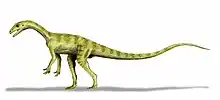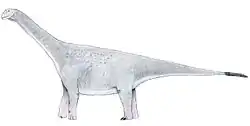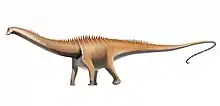| Vulcanodon Temporal range: Sinemurian-Pliensbachian, | |
|---|---|
 | |
| Skeletal diagram showing the known remains | |
| Scientific classification | |
| Domain: | Eukaryota |
| Kingdom: | Animalia |
| Phylum: | Chordata |
| Clade: | Dinosauria |
| Clade: | Saurischia |
| Clade: | †Sauropodomorpha |
| Clade: | †Sauropoda |
| Clade: | †Gravisauria |
| Family: | †Vulcanodontidae |
| Genus: | †Vulcanodon Raath, 1972 |
| Type species | |
| †Vulcanodon karibaensis Raath, 1972 | |
Vulcanodon (meaning "volcano tooth") is an extinct genus of sauropod dinosaur from the Early Jurassic of southern Africa. The only known species is V. karibaensis. Discovered in 1969 in Zimbabwe, it was regarded as the earliest-known sauropod for decades, and is still one of the most primitive sauropods that has been discovered. As a quadrupedal, ground-dwelling herbivore, Vulcanodon already showed the typical sauropod body plan with column-like legs and a long neck and tail. It was smaller than most other sauropods, measuring approximately eleven metres (36 ft) in length. Vulcanodon is known from a fragmentary skeleton including much of the pelvic girdle, hindlimbs, forearms, and tail, but lacking the trunk and neck vertebrae as well as the skull.
Originally, this genus was believed to be a prosauropod because of the knife-shaped teeth found near its fossils, which fit in with the idea that prosauropods were omnivorous. Scientists now know that the teeth belonged to an unidentified theropod that may have scavenged on the Vulcanodon carcass. Vulcanodon is now known to be a true sauropod. Upon the discovery of the related Tazoudasaurus, both animals were unified in the family Vulcanodontidae, though this has not been universally accepted.
Description

Vulcanodon was initially thought have been a small sauropod. In 2010, Gregory S. Paul estimated its length at eleven metres, its weight at 3.5 tonnes.[1] Some books mention lower estimates of approximately 6.5 m (21 ft).[2][3] However, in 2018, researchers have estimated a greater body mass of 10.3 metric tons (11.4 short tons).[4] The thighbone was 110 centimetres (43 in) long.[5]
As one of the earliest and basalmost sauropods, it is important for understanding the early evolution of this group. Sauropods descend from basal sauropodomorphs (informally called "prosauropods"), which were primitively bipedal (two-legged).[6] While Vulcanodon already was fully quadrupedal (four-legged), its limb proportions were intermediate between those of its prosauropod ancestors and those of later, more derived sauropods.[6] Its forelimbs were much more similar to later sauropods than basal sauropodomorphs because they are straight, much more gracile, and the proximal end of the ulna is v-shaped.[7] Unfortunately, no skull or neck of Vulcanodon is known, although it is otherwise very well known.[8]
Hindlimbs and pelvis

Vulcanodon's limbs were sturdy and column-like,[9] and its forelimbs were already proportionally long, reaching 76% of hindlimb length.[10] Its lower leg, metatarsus, and toes were shortened in comparison to its bipedal ancestors, but still not as short as in later sauropods.[6] The sacrum was made out of four fused sacral vertebrae; "prosauropods" possessed only three sacrals. The tail vertebra bodies already showed an incipient excavation of their lateral sides, saving weight and giving them a waisted appearance when viewed from below. In later sauropods, this excavations were enlarged to form extensive perforated pockets called pleurocoels.[5] Contrasting the many sauropod-like features of the skeleton, the pelvis was relatively primitive, reminiscent of its "prosauropod" ancestors.[6][7] One such feature is that the brevis shelf of the ilium has a fossa, which is not found in any more derived sauropods.[11]
The hallux (the first toe of the foot) showed a large claw that was flattened laterally, as seen in "prosauropods".[5] However, the claws of the second and third toe were unusual in being nail-like and broader than deep.[9][12] This feature was also found in the probably closely related Tazoudasaurus, but is absent in all other sauropods.[13] The feet of Vulcanodon were semiplantigrade as in later sauropods (where both the digits and part of the metatarsals contact the ground[6]), a derived feature not found in more basal sauropods like Isanosaurus. However, they also retained primitive features, like the fact that the phalanges were not reduced.[11]
Many of the features found in sauropods that basal sauropodomorphs lack are related to the change in body size. The greatest regions affected by this are the hind limbs and pelvis. For example, an elongating of the ilium, size reduction of the lesser trochanter shelf, and semiplantigrade posture are some features that indicate the amount and positioning of leg muscles being modified. Vulcanodon possessed these features, the latter of which is seen earliest in it. However, Vulcanodon does not have reduced distal phalanges, which are seen in Shunosaurus and all more derived sauropods. This means that while the muscle positioning of its legs were changing, they had not yet reduced in the distal region of the limb.[11]
Discovery


Vulcanodon is known only from a single locality on an island in Lake Kariba, the largest artificial lake in the world, in northern Zimbabwe (formerly Rhodesia).[14] The island, located west of Bumi Hills,[5] is called "Island 126/127", after early, unpublished lake charts, but has no formal name. The first bone was found by B. A. Gibson of the town of Kariba in July 1969, and an excavation team collected the specimen in October 1969, March 1970 and May 1970. In the later half of 1970, the new find was presented at a scientific symposium in Cape Town and a brief note was published. The find was formally named and described in July 1972 by paleontologist Michael Raath.[9] The name Vulcanodon (lat. Vulcanus – Roman god of fire; gr. odon – "tooth")[15] points to the fact that the skeleton was found in sandstone, that was at the time misinterpreted to be part of the Batoka Formation but is actually part of the Forest Sandstone lays a few metres below the lava flows of the Batoka Formation, and emphasizes the peculiar knife-shaped teeth that are now known to belong to a theropod.[9] The specific name, karibaensis, refers to the place of discovery on a small island in Lake Kariba.[9] It was one of the first dinosaurs found in Zimbabwe.[16]
The skeleton (catalogue number QG24) has been found weathering out of a hill slope and was partially eroded by surface exponation and plant roots. It includes the pelvis and sacrum, most of the left hind limb and foot, a right thigh bone, and twelve anterior tail vertebrae. These remains pertain to a single individual as they were all found articulated (still connected together). Additionally, several disarticulated bones were found, including the right forearm and some metacarpalia and phalanges from both the right and left forefeet, probably also pertaining to this individual.[9] Later, the site was revisited by the scientists Geoffrey Bond and Michael Cooper, who were able to collect additional remains including a scapula (specimen QG152, a shoulder blade) and a fragment of a neck vertebra.[5] These remains show that more than one individual was present, and it is possible that they do not pertain to Vulcanodon at all.[17] Today, the Vulcanodon remains are stored in the Natural History Museum of Zimbabwe in Bulawayo.[5]
Raath (1972) noted the discovery of nine fragmentary carnivorous teeth near the pelvic region of the skeleton. He argued that the Vulcanodon carcass might have been embedded with the head and neck bended backwards above the pelvis, a posture called death pose that is frequently seen in dinosaur skeletons. The teeth would have been the only preserved elements of the skull.[9] However, as shown by Cooper (1984), these teeth do not pertain to Vulcanodon but to a theropod dinosaur that may have scavenged on the Vulcanodon carcass.[5]
Classification
|
Originally, Michael Raath (1972) described Vulcanodon not as a sauropod but as an advanced, specialized prosauropod, possibly of the family Melanorosauridae.[9][5] According to Raath, the sauropod-like limb proportions in Vulcanodon evolved independently from those of true sauropods (through convergent evolution). He argued that primitive features of the pelvis as well as the knife-shaped teeth preclude a classification within the Sauropoda.[9] The teeth, however, are now known to belong to a theropod. Arthur Cruickshank (1975) was the first to show that Vulcanodon was indeed a sauropod, arguing that the fifth metatarsal bone was equally long as the remaining metatarsals, a condition seen in other sauropods but not in prosauropods.[18] Today, Vulcanodon is universally accepted to be one of the most basal (primitive) members of Sauropoda.[12][17]
Michael Cooper (1984) erected a new family, the Vulcanodontidae, which he regarded as the "rootstock" for later sauropod families.[5] Originally, the Vulcanodontidae included Vulcanodon and the Indian Barapasaurus, but subsequent studies attributed a number of other, much more fragmentary early sauropod genera to this family, including Ohmdenosaurus and Zizhongosaurus.[19] Paul Upchurch (1995) showed that Barapasaurus was more closely related to later, more advanced sauropods than to Vulcanodon, rendering the Vulcanodontidae polyphyletic and therefore invalid.[10]
The exact relationships with other basal sauropod genera remain unclear. Ronan Allain and colleagues (2004, 2008) found that Vulcanodon is most closely related to Tazoudasaurus, a newly discovered sauropod genus from Morocco. These researchers suggested reintroducing the name Vulcanodontidae to name the clade containing Vulcanodon and Tazoudasaurus.[13][20] However, this sibling relationship between Tazoudasaurus and Vulcanodon could not be confirmed by other analyses.[21][22]
Adam Yates (2004) described a single sauropod tail vertebra from the Upper Elliot Formation of South Africa that may belong to a genus closely related to Vulcanodon. The Upper Elliot Formation is famous for its abundant fossils of the prosauropod Massospondylus.[23]
Vulcanodon in a cladogram after Nair et al., 2012:[24]
| Gravisauria |
| |||||||||||||||||||||||||||||||||||||||||||||||||||||||||||||||
Paleoecology

During the later part of the Lower Jurassic, southern Africa was the scene of massive volcanism, resulting in extensive lava flows (so called flood basalts) that covered much of southern Africa and Antarctica. These basalt formations are known as the Karoo-Ferrar large igneous province. Vulcanodon comes from the "Vulcanodon beds", a fossil-bearing sediment unit within the Batoka Formation, which is composed primarily of flood basalts.[25] The skeleton was found near the top of a 30-metre-thick (98 ft) bedded layer of sand- and siltstone that is over- and underlain by flood basalts.[9]
It was long assumed that Vulcanodon lived during the lowermost (earliest) part of the Jurassic (the Hettangian stage) or at the Triassic–Jurassic boundary, approximately 200 million years ago.[10][17][19] Therefore, it was regarded as the earliest sauropod known, until the discovery of the even older Late Triassic Isanosaurus was announced in 2000.[26] Adam Yates (2004) has recently shown that Vulcanodon is actually much younger than previously thought, dating to the uppermost (latest) part of the Lower Jurassic during the Toarcian stage, approximately 175–183 million years ago.[23][27] Thus, it is contemporary to the closely related Tazoudasaurus.[20] Although the locality of Vulcanodon itself cannot be dated radiometrically because of weathering of the lavas, it would roughly be a contemporary to Karoo lavas from other localities, as the entire sequence of volcanic eruptions was finished within one million years.[23]
Vulcanodon is the only named dinosaur from the Vulcanodon beds.[25] Cooper (1984) noted that the habitat was desert-like, as indicated by aeolian (wind-blown) sands of the Forest Sandstone Formation, which underlies the "Vulcanodon beds". The sediments in which Vulcanodon was found may represent distal alluvial fan deposits which levelled off into a desert landscape, which may have contained lakes during the wet season. The individual may have roamed the shores of wadis that cut into the alluvial fan deposits, unless the carcass was transported to the locality it was found by flooding.[5]
Initially, sauropods were thought to be mainly aquatic, inhabiting lush peat swamps and being captive to the buoyancy of water to support their giant body weights.[28] In 1984, Cooper pointed out that Vulcanodon, the most primitive sauropod known at that time, lived in a desert like environment and therefore must have been terrestrial. This indicated that the large body size of sauropods, as already seen in Vulcanodon, had not evolved as an adaptation to an aquatic life style.[5]
References
- ↑ Paul, G.S., 2010, The Princeton Field Guide to Dinosaurs, Princeton University Press p. 172
- ↑ Benson, R.; Brusatte, S.; Hone, D.; Naish, D.; Xu, X.; Anderson, J.; Clack, J.; Duffin, C.; Milner, A.; Parsons, K.; Prothero, D.; Johanson, Z.; Dennis-Bryan, K. (2012) [2009]. Ambrose, Jamie; Gilpin, David; Hirani, Salima; Jackson, Tom; Joyce, Nathan; Maiklem, Lara; Marriott, Emma; Nottage, Claire; van Zyl, Meizan (eds.). Prehistoric Life: A Definitive Visual History of Life on Earth. Dorling Kindersley. pp. 1–512. ISBN 978-0-7566-9910-9. OCLC 444710202.
- ↑ Holtz, Thomas R. (2008). "Supplementary Information". Dinosaurs: The Most Complete, Up-to-Date Encyclopedia for Dinosaur Lovers of All Ages. Random House. p. 27. ISBN 978-0-375-82419-7.
- ↑ McPhee, Blair W.; Benson, Roger B.J.; Botha-Brink, Jennifer; Bordy, Emese M. & Choiniere, Jonah N. (2018). "A giant dinosaur from the earliest Jurassic of South Africa and the transition to quadrupedality in early sauropodomorphs". Current Biology. 28 (19): 3143–3151.e7. doi:10.1016/j.cub.2018.07.063. PMID 30270189.
- 1 2 3 4 5 6 7 8 9 10 11 Cooper, Michael R. (1984). "A reassessment of Vulcanodon karibaensis Raath (Dinosauria: Saurischia) and the origin of the Sauropoda". Palaeontologia Africana. 25: 203–205, 211–213, 223, 230–231.
- 1 2 3 4 5 Wilson, Jeffrey (2005). "Overview of Sauropod Phylogeny and Evolution". In Rogers; Wilson (eds.). The Sauropods: Evolution and Paleobiology. University of California Press. pp. 27–31. ISBN 978-0-520-24623-2.
- 1 2 Klein, N.; Remes, K.; Gee, C.T.; Sander, M.P. (2011). Biology of the Sauropod Dinosaurs: Understanding the Lives of Giants. Indiana University Press. pp. 136–139. ISBN 978-0-253-35508-9.
- ↑ Poropat, S. F.; Kear, B. P. (2013). "Photographic Atlas and Three-Dimensional Reconstruction of the Holotype Skull of Euhelopus zdanskyi with Description of Additional Cranial Elements". PLOS ONE. 8 (11): e79932. Bibcode:2013PLoSO...879932P. doi:10.1371/journal.pone.0079932. PMC 3836988. PMID 24278222.
- 1 2 3 4 5 6 7 8 9 10 Raath, Michael A. (1972). "Fossil vertebrate studies in Rhodesia: a new dinosaur (Reptilia, Saurischia) from near the Triassic-Jurassic boundary". Arnoldia. 5: 1–2, 4.
- 1 2 3 Upchurch, Paul (29 September 1995). "The Evolutionary History of Sauropod Dinosaurs" (PDF). Philosophical Transactions of the Royal Society of London. Series B, Biological Sciences. 349 (1330): 370–372. Bibcode:1995RSPTB.349..365U. doi:10.1098/rstb.1995.0125.
- 1 2 3 Fechner, R. (2009). "Morphofunctional Evolution of the Pelvic Girdle and Hindlimb of Dinosauromorpha on the Lineage to Sauropoda" (PDF). Fakultät für Geowissenschaften der Ludwigs Maximilians Universität: 111–133.
- 1 2 Wilson, Jeffrey A.; Sereno, Paul C. (1998). "Early Evolution and Higher-Level Phylogeny of Sauropod Dinosaurs" (PDF). Journal of Vertebrate Paleontology. 18 (sup002): 8, 13. Bibcode:1998JVPal..18S...1W. doi:10.1080/02724634.1998.10011115.
- 1 2 3 Allain, Ronan; Najat Aquesbi (2008). "Anatomy and phylogenetic relationships of Tazoudasaurus naimi (Dinosauria, Sauropoda) from the late Early Jurassic of Morocco". Geodiversitas. 30 (2): 403, 404. ISSN 1280-9659.
- ↑ John, Szabo (2011). Dinosaurs. University of Akron: McGraw Hill. p. 81. ISBN 978-1-121-09332-4.
- ↑ Glut, Donald F. (1997). "Vulcanodon". Dinosaurs, the encyclopedia. McFarland & Company, Inc. Publishers. pp. 975–977. ISBN 978-0-375-82419-7.
- ↑ Benton, Michael (2007). Eyewitness Dinosaur Profiles. London: Dorling Kindersley. p. 64. ISBN 978-0-7566-3135-2.
- 1 2 3 Upchurch, Paul; Paul M. Barret; Peter Dodson (2004). "Sauropoda". In David B. Weishampel; Peter Dodson; Halszka Osmólska (eds.). The Dinosauria (2nd ed.). Berkeley: University of California Press. p. 298. ISBN 978-0-520-25408-4.
- ↑ Cruickshank, A. R. I. 1975. Origin of sauropod dinosaurs. South African Journal of Sciences, 71, 89-90.
- 1 2 McIntosh, John; H. Osmolska (1990). "Sauropoda". In David B. Weishampel; Peter Dodson; Halszka Osmólska (eds.). The Dinosauria (1 ed.). Berkeley: University of California Press. p. 376. ISBN 978-0-520-06726-4.
- 1 2 Allain, Ronan; Najat Aquesbi; Jean Dejax; Christian Meyer; Michel Monbaron; Christian Montenat; Philippe Richir; Mohammed Rochdy; Dale Russell; Philippe Taquet (2004). "A basal sauropod dinosaur from the Early Jurassic of Morocco" (PDF). Comptes Rendus Palevol. 3 (3): 199–208. Bibcode:2004CRPal...3..199A. doi:10.1016/j.crpv.2004.03.001. ISSN 1631-0683.
- ↑ Apaldetti, Cecilia; Ricardo N. Martinez; Oscar A. Alcober; Diego Pol (9 November 2011). "A New Basal Sauropodomorph (Dinosauria: Saurischia) from Quebrada del Barro Formation (Marayes-El Carrizal Basin), Northwestern Argentina". PLOS ONE. 6 (11): e26964. Bibcode:2011PLoSO...626964A. doi:10.1371/journal.pone.0026964. PMC 3212523. PMID 22096511.
- ↑ Remes, Kristian; Francisco Ortega; Ignacio Fierro; Ulrich Joger; Ralf Kosma; José Manuel Marín Ferrer; Oumarou Amadou Ide; Abdoulaye Maga (16 September 2009). "A New Basal Sauropod Dinosaur from the Middle Jurassic of Niger and the Early Evolution of Sauropoda". PLOS ONE. 4 (9): e6924. Bibcode:2009PLoSO...4.6924R. doi:10.1371/journal.pone.0006924. PMC 2737122. PMID 19756139.
- 1 2 3 Yates, Adam M.; P. John Hancox; Bruce S. Rubidge (2004). "First record of a sauropod dinosaur from the upper Elliot Formation (Early Jurassic) of South Africa". South African Journal of Science. 100 (9–10): 504–506. ISSN 0038-2353.
- ↑ Nair, J. P.; Salisbury, S. W. (2012). "New anatomical information on Rhoetosaurus brownei Longman, 1926, a gravisaurian sauropodomorph dinosaur from the Middle Jurassic of Queensland, Australia". Journal of Vertebrate Paleontology. 32 (2): 369. Bibcode:2012JVPal..32..369N. doi:10.1080/02724634.2012.622324. S2CID 85317450.
- 1 2 Weishampel, David B.; Barrett, Paul M.; Coria, Rodolfo A.; Le Loeuff, Jean; Xu Xing; Zhao Xijin; Sahni, Ashok; Gomani, Elizabeth M. P.; Noto, Christopher R. (2004). "Dinosaur distribution". In Weishampel, David B.; Dodson, Peter; Osmólska, Halszka (eds.). The Dinosauria (2nd ed.). Berkeley: University of California Press. p. 535. ISBN 978-0-520-24209-8.
- ↑ Buffetaut, Eric; Varavudh Suteethorn; Gilles Cuny; Haiyan Tong; Jean Le Loeuff; Sasidhorn Khansubha; Sutee Jongautchariyakul (7 September 2000). "The earliest known sauropod dinosaur". Nature. 407 (6800): 72–74. Bibcode:2000Natur.407...72B. doi:10.1038/35024060. ISSN 0028-0836. PMID 10993074. S2CID 4387776.
- ↑ Wilson, Jeffrey A. (20 June 2005). "Integrating ichnofossil and body fossil records to estimate locomotor posture and spatiotemporal distribution of early sauropod dinosaurs: a stratocladistic approach". Paleobiology. 31 (3): 406. doi:10.1666/0094-8373(2005)031[0400:IIABFR]2.0.CO;2. ISSN 0094-8373. S2CID 86366057.
- ↑ Henderson, Donald M. (7 May 2004). "Tipsy punters: sauropod dinosaur pneumaticity, buoyancy and aquatic habits". Proceedings of the Royal Society B: Biological Sciences. 271 (Suppl_4): 180–183. doi:10.1098/rsbl.2003.0136. ISSN 0962-8452. PMC 1810024. PMID 15252977.









